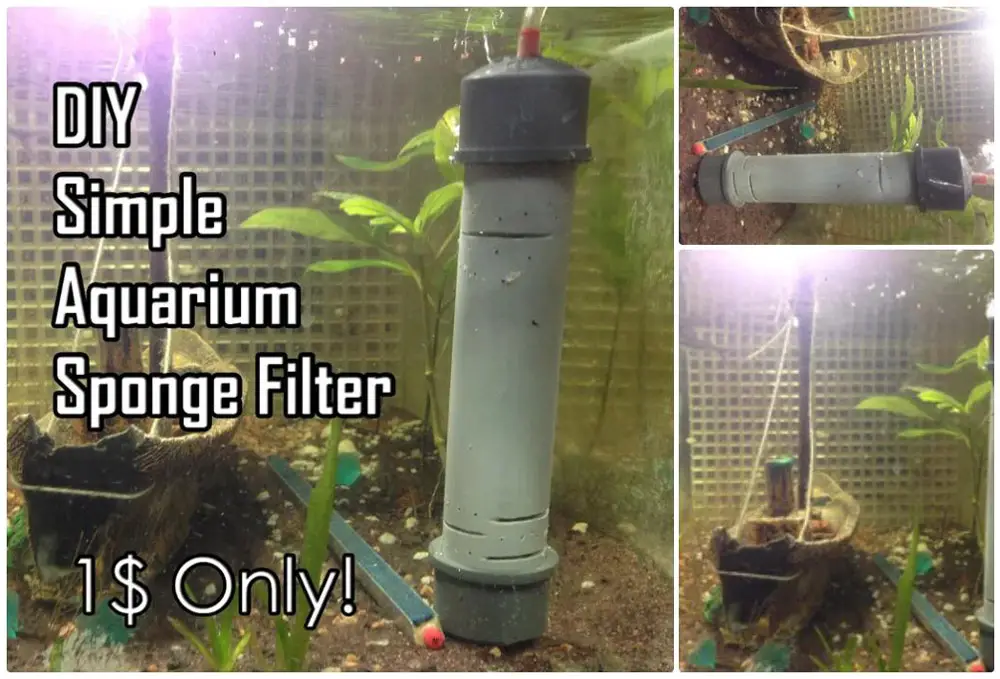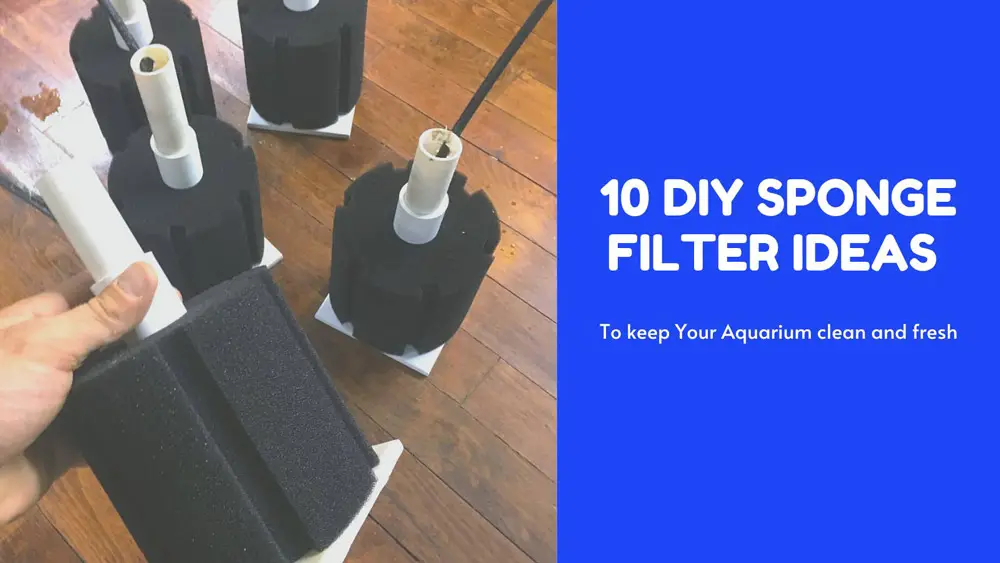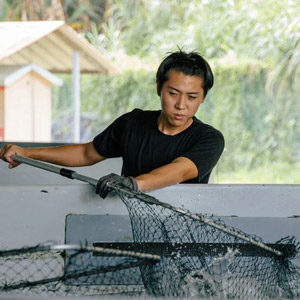I’m sure no one would like a messy fish tank filled with dead fish and covered with mystery oily films like the one we’ve seen in the Netflix documentary Monster: The Jeffrey Dahmer Story.
That’s right. It’s unsightly and just downright nasty.
Being a REAL fish keeper, you take responsibility for providing a healthy environment with clean and fresh water. Of course, the secret is simply – giving them a good filtration system.
Sponge filters are a great way to mechanically collect debris in the water, making your water clearer. These types of filters are often used in hospital isolation and fry tanks, but they can also be used as supplemental filters in larger community tanks.
Most sponge filters consist of three basic components: a piece of filter sponge, an air pump, and airline tubing. Prices for sponge filters can range anywhere from $5 to $40, depending on the brand and size.
Owing to their simplicity, you can make your own sponge filter! I’ve put together stacks of 7 simple and practical DIY sponge filter ideas (with video instructions) for you to easily follow along.
DIY Versatile Bottle Filtration System with Media
In this video, Joey shows us how to make an easy all-in-one bottle filtration system using an empty plastic bottle. It features both mechanical and biological filtration. You can also add chemical filter media if you want to.
Additionally, it works as a surface skimmer because it has an air intake at the top which pulls in surface water containing all the oils and other debris. This versatile little filter can also become a gravel vacuum in a second.
If you plan to use it in a larger aquarium, no problem! Just scale it with a bigger bottle. It should be noted that you must choose the proper aquarium pump.
As a bonus, it’s very easy to clean because you can just remove the entire thing from the bottle, rinse it off, and put it back in.
DIY Mini Bottle Sponge Filter for Shrimp & Fry Tank
Sponge filters are excellent for breeding tanks simply because the sponge prevents these critters from being drawn into the filter. This DIY shrimp sponge filter is a variation of the one above, but it is simpler and more efficient.
Unlike other designs, this one has a sponge on the outside of the bottle instead of the inside. This protects your fry or shrimp even more and still provides much-needed oxygen for your fry.
Put biological filter media in the bottle, fill it up with water, screw on the cap, and you’re ready to boost your biological filtration. The only downside, in my opinion, is that it’s not as aesthetically pleasing as some of the other designs.
DIY Sponge Filter with Airstone
Excellent design, this one would be my favorite. It’s easy to make, effective, and looks good.
This sponge filter has a nice heavy ceramic base, which helps to weigh it down and keep it in place. Like Mike, I personally don’t like the bubbling sound from a sponge filter, so I would suggest adding air stones.
As you may know, Aquariumcoop sells the same product, but it’s a bit expensive. This DIY version will cost you less than $5!
DIY Simple PVC Pipe Sponge Filter for Aquariums

Clearly, this one works better in aquariums with small to medium-sized digging fish due to its solid structure. However, it can be used in a shrimp tank as well. Just be sure to use a smaller piece of PVC pipe.
All you need is a piece of PVC pipe, depending on your tank size, a sponge, water bottle caps, airline tubing, and an air pump. It’s a quick and dirty design, but it will definitely get the job done.
Ensure the holes and cuts are big enough to let water flow through but not so big that your shrimp or fry can escape.
Get the PVC Pipe Sponge Filter tutorial here: Instructables
Cheap and Simple DIY Aquarium Coarse Sponge Filter
Another cheap and easy-to-build DIY sponge filter by Joey. This one doesn’t require a plastic water bottle. Instead, you’ll need a 3/4″ PVC pipe, which allows you to attach an air stone and pull it back to any location in the pipe you want.
I prefer to use coarse foam. It has the perfect density – not too porous or too dense, making the frequency of cleaning much less.
Depending on your tank size and bioload, you may want to stack a second or several sponges on top of each other for extra filtration.
Author notes: I have no study to support my claim. It is strictly based on my anecdotal Mbuna experience only. Like any other Cichlids, Mbunas have their own distinct personality. Even a peaceful Yellow Lab can be nasty. You might have a different experience.
DIY Aquarium Filter for Bettas
Looking for a DIY filter for your Betta fish? Check out this Worlds smallest DIY filter! This filter is designed to be used in a small aquarium or jar.
Like the DIYed bottle filter, this one uses a pill bottle; it’s much smaller. Simply drill holes in the bottle and cap, insert filter material, place it in your aquarium, and you’re good to go.
One thing to keep in mind, smooth the edges of the holes you drill to avoid hurting your Betta.
DIY Double Biological Sponge Filter in Aquarium
A double sponge filter can hold more mechanical and biological media and, as a result, can handle a larger bioload. This makes it ideal for heavily stocked aquariums.
The whole setup is a bit more complicated than the other designs, but if you’re looking for something that will do a great job of filtering your water, this is it.
- 【Multi-filtration Functions】Upettools sponge filter combines single scientific 7-layer ribbing shape...
- 【Special Ceramic Bio Filter Media】Upettools aquarium sponge filters compatible with one container...
- 【Removable Sponges 】 You can take down the sponge from the filter easily to clean or replace it....
- 【We have added more accessories】Package include: 1 double sponge filter with 2 containers +2 suctions...
- 【Max Suit for 55GAL Fish Tank】Compatible with 2 suction cups, can be installed anywhere and can be...
Things to Keep in Mind
While building your own DIYed sponge filter is cheaper and can be very exciting, you should keep a few things in mind.
- Silicone has a strong vinegar smell, so it’s best to do these projects in a well-ventilated area.
- Wear gloves while working with silicone, and have rags handy to wipe your hands.
- Measure twice, cut once. This will save you a lot of time and frustration.
- A small air pump is required to run a sponge filter.
- If you want a quiet sponge filter, use an airstone inside.
- It’s best to clean this filter during a water change.
Wrapping Up
As you can see, it’s not always necessary to spend a lot of money on filters, especially if you’re just starting out with fishkeeping. DIY sponge filters are not only easy and cheap to make, but they’re also very effective at filtering water. So, what are you waiting for? Get building!






